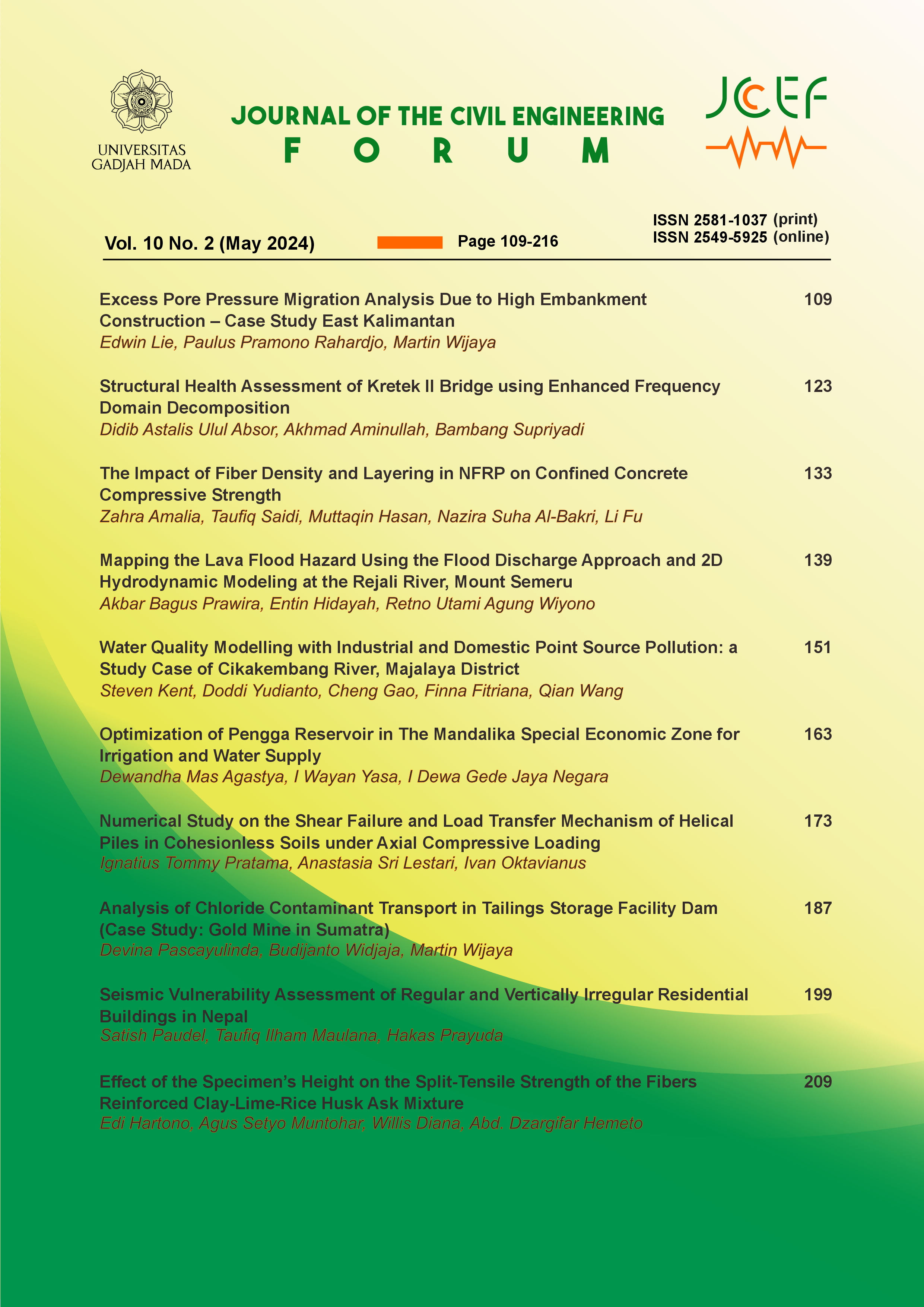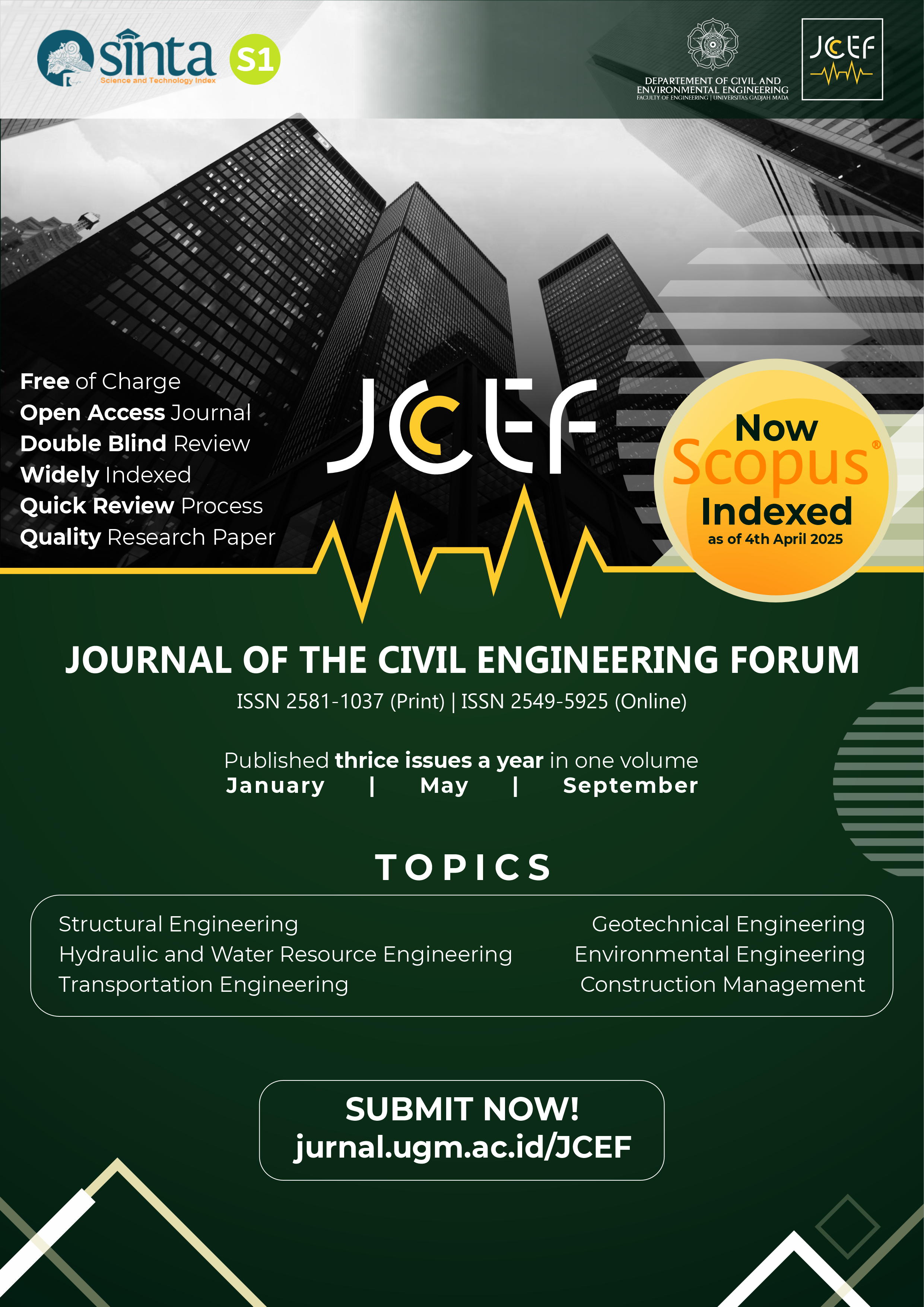Analysis of Chloride Contaminant Transport in Tailings Storage Facility Dam (Case Study: Gold Mine in Sumatra)
Abstract
In the practice of gold mining industry, hazardous waste known as tailings is produced during the ore extraction process. These tailings are typically stored in a dam structure called a Tailings Storage Facility (TSF). The planning and construction of a TSF are critical considerations, as the failure of a TSF can have substantial environmental impacts, pose risks to human safety, and result in industrial losses. Therefore, strict control is necessary in the development of TSFs to minimize the potential negative consequences. This research focuses on the transport of contaminants within a TSF, specifically examining the concentration of chloride contaminants and conducting particle movement analysis. The study utilizes modeling through the GeoStudio SEEP/W program to simulate groundwater flow profiles and the GeoStudio CTRAN/W program to understand contaminant movement over a 100-year period. GeoStudio modeling employs 10 materials: impermeable clay soil, filter sandy soil, transition gravel rock, three mine waste types (Fine, Rockfill, and Rockfill with fine), hard rock bedrock layer, in-situ soil representing the original layer, landslide with colluvial soil, and the tailings itself. Back analysis is employed to iterate model parameters and ensure modeling accuracy against field data, including comparisons with water quality test results and readings from vibrating wire piezometer (VWP) instrumentation. The contaminant transport is influenced by advection-dispersion processes and tends to concentrate within the TSF boundary toward the dam toe over a 100-year timeframe. The analysis emphasizes the influence of advection in contaminant transport and underscores the importance of particle position relative to the groundwater level, with Particle Tracking Analysis shows significant movement within the groundwater flow area. This research provides crucial insights into the dynamics of contaminant concentration, informing better decision-making in TSF planning and management. The findings underscore the imperative of strict control measures to minimize environmental impacts and human safety risks associated with TSFs, thereby advancing knowledge in gold mining waste management.
References
Bear, J. (1972), Dynamics of Fluid in Porous Media, American Elsevier Press. URL: https://doi.org/10.1016/B978-0-08-095703-9.00012-X
Cao, G. et al. (2019), ‘Experimental study of shear wave velocity in unsaturated tailings soil with variant grain size distribution’, Construction and Building Materials . URL: https://doi.org/10.1016/j.conbuildmat.2019.06.169
Domenico, P. A. and Schwartz, W. (1998), Physical and Chemical Hydrogeology, 2 edn, John Wiley & Sons Inc. URL: https://doi.org/10.1002/9780470172766
GEOSLOPE International Ltd. (2018), Heat and Mass Transfer Modeling with GeoStudio. [Brochure]. Calgary, Alberta, Canada.
Glotov, V. E. et al. (2018), ‘Causes and environmental impact of the gold-tailings dam failure at karamken, the russian far east’, Engineering Geology. URL: https://doi.org/10.1016/j.enggeo.2018.08.012
Jewell, R. (1998), ‘An introduction to tailings’, Case Studies on Tailings Management 1, 7–8.
Kim, S. Y. et al. (2023), ‘Estimation of soil porosity in mine tailing using parameters from instrumented oedometer test’, Engineering Geology. URL: https://doi.org/10.1016/j.enggeo.2023.10706
Owen, J. K., Kemp, D., Lèbre, A. et al. (2020), ‘Catastrophic tailings dam failures and disaster risk disclosure’, International Journal of Disaster Risk Reduction 42. URL: https://doi.org/10.1016/j.ijdrr.2019.101361
Piciullo, L. et al. (2022), ‘A new look at the statistics of tailings dam failures’, Engineering Geology. URL: https://doi.org/10.1016/j.enggeo.2022.106657
Rana, N. M. et al. (2021), ‘Catastrophic mass flows resulting from tailings impoundment failures’, Engineering Geology. URL: https://doi.org/10.1016/j.enggeo.2020.105978
Reichl, C. and Schatz, M. (2023), World Mining Data 2023, Federal Ministry of Agriculture, Regions and Tourism, Vienna.
Rico, M. et al. (2008), ‘Reported tailings dam failures: a review of the european incidents in the worldwide context’, Journal of Hazardous Materials. URL: https://doi.org/10.1016/j.jhazmat.2007.05.057
Song, S., Yan, S. and Liu, X. (2017), ‘Influence of iron ore tailings powder on the performance of high fluidity concrete’.
Villavicencio, G., Espinace, R., Palma, J., Fourie, A. and Valenzuela, P. (2014), ‘Failures of sand tailings dams in a highly seismic country’, Canadian Geotechnical Journal 51, 449–464. URL: https://doi.org/10.1139/cgj-2013-0142
Wang, H. (2008), Dynamics of Fluid flow and contaminant transport in porous media, Higher Education Press.
Wang, V. (2021), ‘Analysis of seepage, contaminant transport, compaction and safety of the zhaoli ditch dam, a tailing reservoir’. Dissertation.
Copyright (c) 2024 The Author(s)

This work is licensed under a Creative Commons Attribution-ShareAlike 4.0 International License.
Copyright is granted to authors for the purpose of providing protection for articles written to describe experiments and their results. JCEF will protect and defend the work and reputation of the author and are also willing to address any allegations of violation, plagiarism, fraud, etc. against articles written and published by JCEF. JCEF is published under the terms of the Creative Commons Attribution-ShareAlike 4.0 International License (CC BY-SA 4.0). The author holds the copyright and assigns the journal rights to the first publication (online and print) of the work simultaneously.





